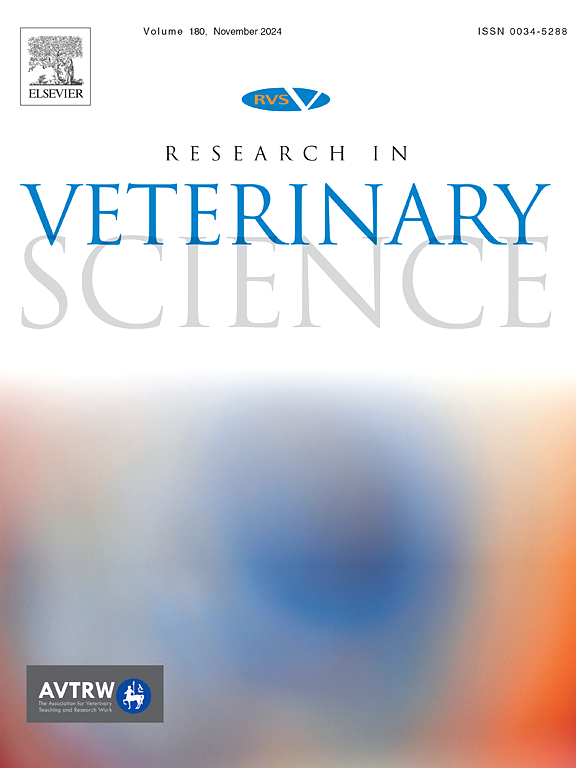基于机器学习的乔里斯坦牛红细胞检测与定量:试点研究
IF 2.2
3区 农林科学
Q1 VETERINARY SCIENCES
引用次数: 0
摘要
本研究首次介绍了使用机器学习检测和计数巴基斯坦Cholistani牛的正常和异常红细胞(rbc),包括泪滴细胞和血吸虫细胞。采用支持向量机(SVM)模型,并与人工计数方法进行比较。使用对比度拉伸变换对预注释的血液涂片图像进行预处理,然后进行分割和调整大小。对标记的数据集进行扩充,并采用主成分分析(PCA)进行特征约简。将数据集随机分为训练子集(80%)和测试子集(20%),对SVM模型进行相应的训练和评估。在所有研究的细胞类型中,人工和机器学习的RBC计数无统计学差异(P≥0.05)。正常红细胞的分类概率最高(87%),其次是泪滴细胞(84%)和血吸虫细胞(73%)。泪滴细胞准确率最高(0.991),正常红细胞次之(0.965),裂细胞次之(0.707)。精度值也有类似的趋势,正常红细胞最高(0.932),其次是泪滴细胞(0.921)和血吸虫细胞(0.855)。这些发现表明,机器学习,特别是基于支持向量机的模型,可以准确准确地检测和计数正常红细胞和Cholistani牛的泪滴细胞。然而,需要使用卷积神经网络或其他深度学习方法进一步改进RBC检测。这项研究强调了人工智能在兽医学血液学评估中的潜力。本文章由计算机程序翻译,如有差异,请以英文原文为准。
Machine learning-based detection and quantification of red blood cells in Cholistani cattle: A pilot study
This study presents the first account of using machine learning to detect and count normal and abnormal red blood cells (RBCs), including tear-drop cells and schistocytes, in Cholistani cattle from Pakistan. A Support Vector Machine (SVM) model was applied and compared with manual counting methods. Pre-annotated blood smear images were preprocessed using contrast stretching transformation, followed by segmentation and resizing. Labeled datasets were augmented, and Principal Component Analysis (PCA) was employed for feature reduction. The dataset was randomly split into training (80 %) and testing (20 %) subsets, and the SVM model was trained and evaluated accordingly. No statistically significant difference (P ≥ 0.05) was observed between manual and machine learning-based RBC counts for all the studied cell types. The highest classification probability was recorded for normal RBCs (87 %), followed by tear-drop cells (84 %) and schistocytes (73 %). Accuracy was highest for tear-drop cells (0.991), followed by normal RBCs (0.965) and schistocytes (0.707). Precision values followed a similar trend, with the highest for normal RBCs (0.932), followed by tear-drop cells (0.921) and schistocytes (0.855). These findings suggest that machine learning, particularly SVM-based models, can accurately and precisely detect and count normal RBCs and tear-drop cells in Cholistani cattle. However, further refinements are needed to improve RBC detection using convolution neural networks or other deep learning approaches. This study highlights the potential of artificial intelligence for hematological assessments in veterinary medicine.
求助全文
通过发布文献求助,成功后即可免费获取论文全文。
去求助
来源期刊

Research in veterinary science
农林科学-兽医学
CiteScore
4.40
自引率
4.20%
发文量
312
审稿时长
75 days
期刊介绍:
Research in Veterinary Science is an International multi-disciplinary journal publishing original articles, reviews and short communications of a high scientific and ethical standard in all aspects of veterinary and biomedical research.
The primary aim of the journal is to inform veterinary and biomedical scientists of significant advances in veterinary and related research through prompt publication and dissemination. Secondly, the journal aims to provide a general multi-disciplinary forum for discussion and debate of news and issues concerning veterinary science. Thirdly, to promote the dissemination of knowledge to a broader range of professions, globally.
High quality papers on all species of animals are considered, particularly those considered to be of high scientific importance and originality, and with interdisciplinary interest. The journal encourages papers providing results that have clear implications for understanding disease pathogenesis and for the development of control measures or treatments, as well as those dealing with a comparative biomedical approach, which represents a substantial improvement to animal and human health.
Studies without a robust scientific hypothesis or that are preliminary, or of weak originality, as well as negative results, are not appropriate for the journal. Furthermore, observational approaches, case studies or field reports lacking an advancement in general knowledge do not fall within the scope of the journal.
 求助内容:
求助内容: 应助结果提醒方式:
应助结果提醒方式:


